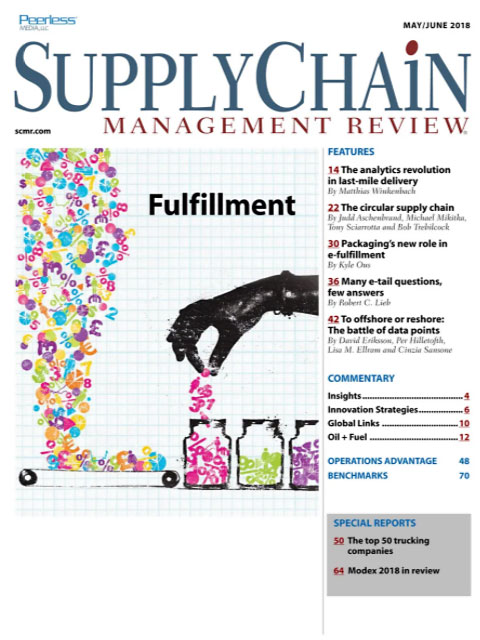Sorry, but your login has failed. Please recheck your login information and resubmit. If your subscription has expired, renew here.
May-June 2018
Last month, I was in Atlanta at the Modex trade show. In one sense, it is a tribute to the automation technologies managing today’s distribution networks. And, I’m not only talking about automated materials handling systems, but also the software and NextGen technologies such as robotics, wearable technologies, including smart glasses and augmented reality solutions and sensors enabling the Internet of Things. In another sense, all of these solutions are coming together to drive fulfillment. With the increase in e-commerce, getting the right product to the right customer at the right time has never been more important. Browse this issue archive.Need Help? Contact customer service 847-559-7581 More options
Urbanization is progressing at a rapid pace. The United Nations projects that by 2030 the number of so-called megacities of over 10 million inhabitants will rise to well above 40. About two-thirds of the global population is expected to reside in cities by 2050. Without a doubt, cities represent the epicenters of future global economic growth as well as the social, technological and cultural advancement of humanity.
The supply chain implications of these trends are profound. To remain competitive, companies across all sectors, industries and markets need to succeed at serving urban customers and consumers. This is particularly true in retail, where the battle over future consumer markets is largely a battle over who excels at managing the urban last mile of physical distribution.
Strategies for change
As urban populations grow, cities are becoming an increasingly complex and uncertain operational environment. The key driver of this complexity is a rapid increase in urban density. The potential of any city to grow in geographical size is naturally bounded. At some point, cities find that to keep growing they must build upwards to accommodate more people, businesses and activities.

This complete article is available to subscribers only.
Log in now for full access or start your PLUS+ subscription for instant access.
SC
MR
Sorry, but your login has failed. Please recheck your login information and resubmit. If your subscription has expired, renew here.
May-June 2018
Last month, I was in Atlanta at the Modex trade show. In one sense, it is a tribute to the automation technologies managing today’s distribution networks. And, I’m not only talking about automated materials… Browse this issue archive. Access your online digital edition. Download a PDF file of the May-June 2018 issue.Urbanization is progressing at a rapid pace. The United Nations projects that by 2030 the number of so-called megacities of over 10 million inhabitants will rise to well above 40. About two-thirds of the global population is expected to reside in cities by 2050. Without a doubt, cities represent the epicenters of future global economic growth as well as the social, technological and cultural advancement of humanity.
The supply chain implications of these trends are profound. To remain competitive, companies across all sectors, industries and markets need to succeed at serving urban customers and consumers. This is particularly true in retail, where the battle over future consumer markets is largely a battle over who excels at managing the urban last mile of physical distribution.
Strategies for change
As urban populations grow, cities are becoming an increasingly complex and uncertain operational environment. The key driver of this complexity is a rapid increase in urban density. The potential of any city to grow in geographical size is naturally bounded. At some point, cities find that to keep growing they must build upwards to accommodate more people, businesses and activities.
SC
MR


More 3PL
- U.S.-bound containerized import shipments are up in June and first half of 2024
- Not out of the woods
- One door closes, a better one opens
- AI liftoff delayed?
- Procter & Gamble’s Amy Rardin announced as NexGen Supply Chain keynote speaker
- Developing a dynamic S&OP process for third-party logistics
- More 3PL
Latest Podcast

 Explore
Explore
Business Management News
- U.S.-bound containerized import shipments are up in June and first half of 2024
- Expand supply chain metrics to cover the complete customer experience
- When disaster strikes, the supply chain becomes the key to life
- Leadership development for supply chain leaders
- A smarter approach to sustainability is vital for healthy, resilient supply chains
- When the scales tilt: Making vaccine access work for all
- More Business Management
Latest Business Management Resources

Subscribe

Supply Chain Management Review delivers the best industry content.

Editors’ Picks





